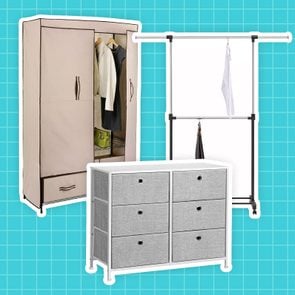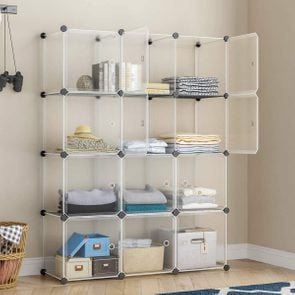How to Organize a Closet Once and for All
Updated: Mar. 13, 2024
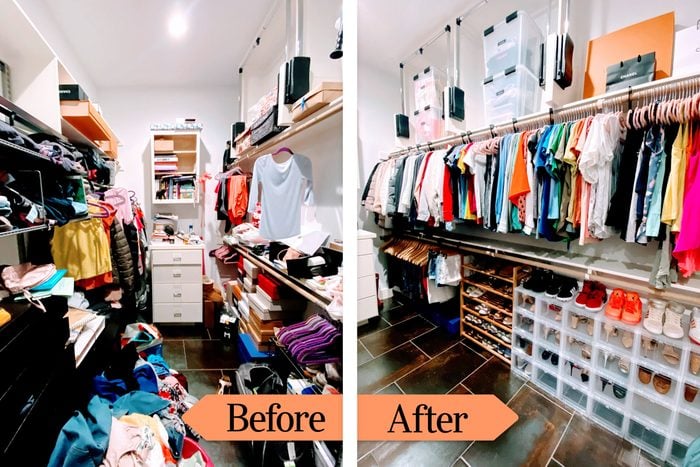
These closet organization ideas will make your mornings—and your life—easier. You'll never again be stumped by the question "What should I wear today?"
When it comes to home organization, tackling your bedroom closet is perhaps one of the most difficult yet ultimately satisfying tasks. While organizing a utility closet, linen closet, or pantry involves editing and categorizing everyday items such as cleaning supplies, towels, and nonperishable foods that probably don’t trigger any sentimental feelings, many of us become attached to our clothes, shoes, and accessories along with the memories sparked at the sight of them. However, keeping clothing you no longer wear while adding more pieces, can result in a jumbled, cluttered closet that makes it harder for you to find the pieces you truly enjoy and feel confident wearing each and every day.
Ready to get started but unsure of how to organize your closet? It’s actually a lot easier than you think. “It’s all about taking the time to create intentional, easy to maintain spaces,” Laynē Brookshire, CEO and founder of Ms. Placed Professional Organizing in Austin, Texas tells Reader’s Digest. All you need to do is set aside some time, have the willingness to let go of that mini dress you haven’t worn since college, and start planning.
Reader’s Digest has put together this step-by-step guide filled with hundreds of practical and helpful closet organization ideas.
On This Page
What you’ll need
Before you lift a finger, take a moment to plan out your “how to organize your closet” strategy. “Outline your goals, expectations, and vision for your closet space before you get started so you can map out a plan and work strategically to get the results you want,” says Brookshire. “This beginning step will help you keep your focus when making decisions and help motivate if you lose momentum in the process—and it is a process. But stick to it, because the end results will be so worth it!”
Here’s what you need:
- Reusable shopping bags or laundry baskets to create keep, toss, donate, and sell piles.
- A box to store all the items that go elsewhere in the home; think umbrellas, miscellaneous cleaning supplies, etc. “At the end of the sorting you can take those items to their zone throughout the house and free up that space in your closet,” explains Brookshire.
- Matching hangers.
- Several key closet organizers.
- A tape measure.
- A full-length mirror for a makeshift dressing room.
- Motivation and a great playlist (Spotify has a number of ready-made cleaning playlists.)
- Time in your schedule to take donations to a drop-off point. You’ll immediately feel lighter once they’re out of the house.
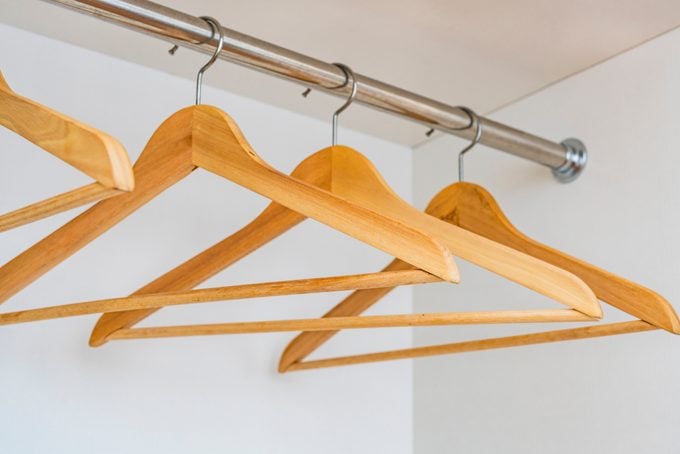
Clean and empty your closet
This step may seem like it requires the least amount of effort, but it is actually quite difficult. “The process of physically emptying out your closet is painful but a must if you really want to get honest with yourself about your actual wardrobe inventory and find out just how many black sweaters you own,” she says. You may even rediscover some favorite pieces you forgot about. Before getting started, take some before photos so you can track your progress. Then, pull everything—yes, everything!—out of your closet and drawers and pile them into categories of different items, such as tank tops, short sleeves, long sleeves, leggings, jeans, etc.
Once your closet is empty, think of it a little like spring cleaning, and use it as an opportunity to literally clean your closet, wiping down hanging rods and cleaning out any shelves or bins that have attracted dust to give you a fresh, clean slate. While the shelves are empty, measure the depth and width; you’ll use these measurements to determine which organizing products or closet systems will fit best.
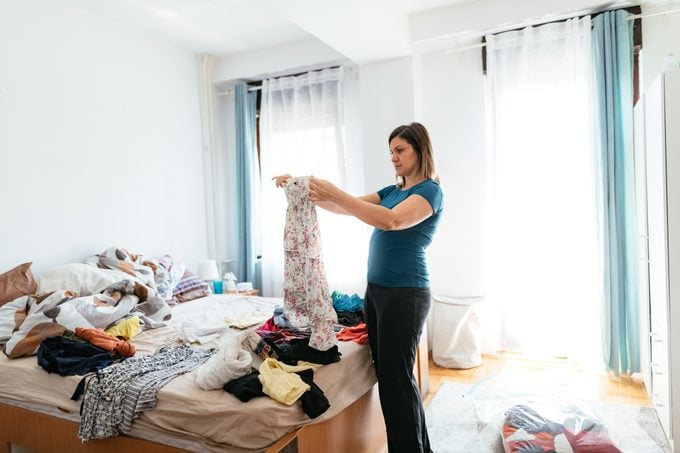
Declutter your clothes
After you’ve cleared out and cleaned your space, the next step is to determine which items you will be keeping in your wardrobe and your closet—and which you are willing to say goodbye to. A closet purge can be one of the most time-intensive steps, as this is when you are really going to have to edit down your belongings. “For maximum impact, try to complete this step in one day,” suggests Brookshire. You might want to consider creating a capsule wardrobe, a curated collection of coordinating pieces that make getting dressed a breeze.
Go through each pile of clothing and sort it into categories:
- Keep: These are all the items you can’t live without. If you’re on the fence about an item, ask yourself: Do you feel confident and beautiful in this item? Does it flatter your figure? How often do you wear it? Can it be mixed and matched with other items in your wardrobe? “Ask yourself, ‘Would I feel good if I unexpectedly ran into my ex wearing this outfit?'” suggests Brookshire about this crucial category.
- Toss: Items that are seriously stained, have rips that are beyond repair, or, for whatever reason, are in such bad condition that even a donation center wouldn’t take them, should get thrown away in the trash, compost them, or turn them into rags for cleaning.
- Sell: Designer jeans, trendy clothes that are in good shape, shoes, and handbags are among the items you might be able to sell online or at a local consignment store. “In particular, any item that’s within the last season that is still a current trend or style, can potentially be sold,” Brookshire says. Before you create this pile, check out reselling app Poshmark or your local consignment store’s website to see if similar items are in demand…or not. This could save you time frustration in the long run.
- Donate: Donate items that are gently worn but simply don’t spark much joy for you anymore. “Anything in good shape that still serves its intended function, but you don’t love anymore may find a new home with someone else who will love it and use it,” says Brookshire.
- Recycle: Got any old denim? Some clothes can actually be recycled. Madewell, for example, takes jeans and recycles them into home insulation for building new homes. Bonus: You get a discount on a new pair when you donate your old ones at their stores.
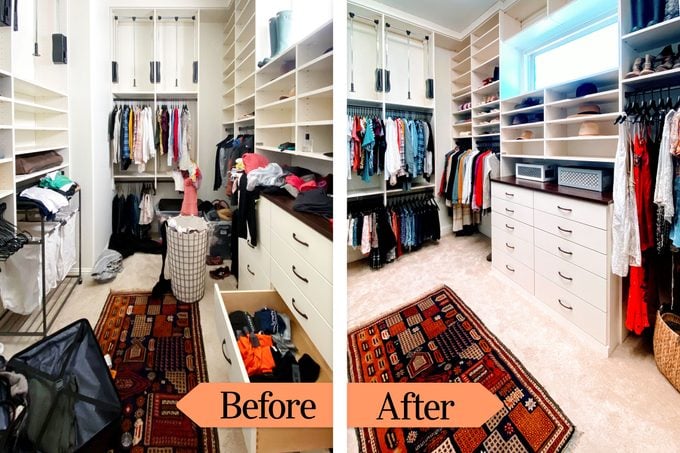
Blueprint your closet design
This is when you need to think about what you envision when you think about an organized closet—and yours in particular. It’s likely you have seen a home organization show, scoured Pinterest or Instagram, or read about a few organization hacks in a magazine. Also, think about ways you can make your closet a place you actually want to spend time in, within the confines of its physical space and your budget. Ideally, you want to create a space that blends intention with design so you feel happy and are infused with positive energy when you enter. Worried this sounds too expensive? “You can make an enormous impact without needing to fully remodel your space,” Brookshire says. Here’s how:
- Give it a fresh coat of paint. If your closet has seen better days, a fresh coat of paint can do wonders. You don’t want a bright or dark color that will reflect off your clothing and alter its appearance, but you do have options beyond stark white. Soft gray, light khaki, and eggshell are all traditional choices.
- Light up the space. Any room—including your closet—can be transformed with the right lighting. “Lighting alone can make all the difference,” Brookshire points out. If there is already a fixture in place, consider swapping it out for one you love—chandeliers in a closet are what Pinterest dreams are made of! If there is no lighting at all, consider investing in some self-stick battery-operated lights or one of these other closet lighting ideas.
- Think vertical. How much space do you have? Consider how the space can be used more efficiently with products or tools to climb the walls and take advantage of all available room.
- Add a mirror. This will make the space look and feel brighter, more open, and give you a place to check your style before heading out the door. Opt for one with an attention-grabbing frame to add an aesthetic touch.
- Take advantage of a vanity. A built-in or standalone vanity is a great drop zone, but don’t let it get piled with clutter. “Use it for a surface to fold or place your outfit for the following day, or stage items you are packing for a trip,” Brookshire says, adding that her personal favorite use for a vanity is to display jewelry.
- Consider an island. If you have a large walk-in closet, islands give you a place to display something beautiful like fresh flowers or framed photos, a hat stand, or a vintage piece that you love. “By intentionally adding something to the center of this space, you will create a no-clutter zone and will be less inclined to allow it to get messy,” explains Brookshire. “It really adds a mature element of design and makes your closet its own space beyond a simple storage closet.”
- Try a chair pouf. Adding a chair pouf is a perfect example of intention mixed with design, Brookshire says. Not only can it be a really cute focal point and a pop of color, but it also serves as a bonus place to perch your foot when buckling sandals or applying lotion to your legs when you’re wearing a short skirt.
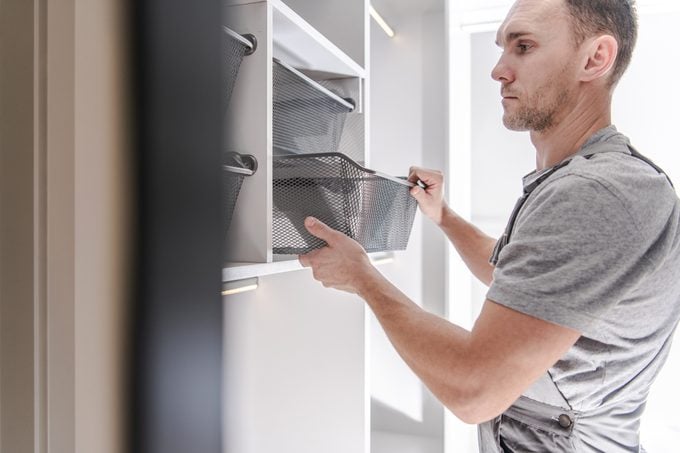
Strategize your closet storage
While closet storage solutions can’t make your closet bigger, they can help make it a more efficient and effective space for your needs. “Products can make or break a space; the right ones magically make a closet great without the expense, time, or headache of a full remodel,” Brookshire explains. Organizers can also help create a physical boundary for your zones to stay in their lane without overlapping and getting messy all over again.
- Invest in a closet system. If you don’t already have a streamlined closet system—meaning your closet consists of a hanging rod and that’s it—you might want to consider investing in one. These systems (popular ones include ELFA, ClosetMaid, Wayfair’s Dotted Line, or one of the many organizers sold on Amazon) can be a major game-changer, as they allow you to design and customize your space with exactly what you need. Even if your closet is small you can make it more functional with the right organizational system.
- Stock up on containers. Whether you prefer plastic boxes or fabric bins, “implementing containers allows you to keep categories separate and provides easy access and easy systems to maintain,” Brookshire explains. If a store-bought organizer isn’t in your budget, try these DIY closet organizer ideas.
- Invest in space-saving hangers. When it comes to hangers, swap all your mismatched wire and plastic hangers for slender velvet ones and perhaps a few wooden hangers for heavier winter coats. This small investment will make a huge impact on the overall look and function of your space.
- Optimize vertical space. If you don’t have a lot of shelf space, consider adding hanging shoe storage or hanging shelves to create some.
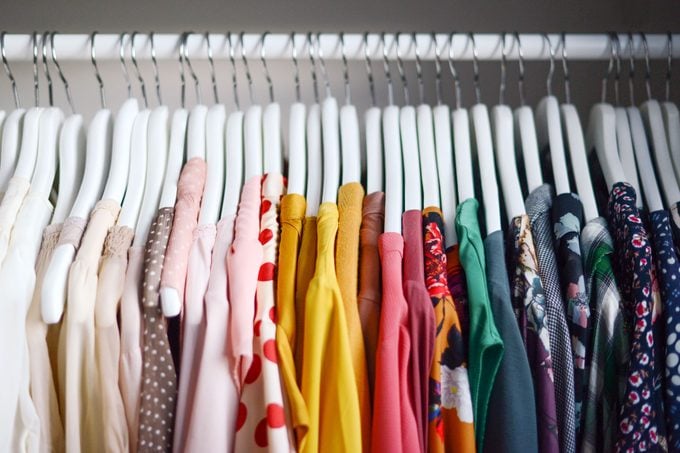
How to organize your clothes
When organizing your closet think about solutions that you will actually be able to maintain day after day. This means ditching any options that would require several steps to put clothing away in favor of keeping it simple. “Ideally, you want your clothing and outfit selection to be easy and putting away laundry to be a breeze,” Brookshire says. The best closet organization ideas will also help you identify what items of clothing you need.
Best ways to organize clothes
First, consider the frequency of use of your clothing, Brookshire suggests, adding that this is especially important if you have a small closet. “You always want to think about your prime real estate spaces and put the items that you access the most in these zones,” she explains. Prime real estate is any space that is easily visible and accessible, with nothing blocking access to it. It’s usually between waist and shoulder height.
You can also organize by theme or occasion. For example, keeping separate sections for your dress clothes, work clothes, casual clothes, etc.
Organizing by style is also key, allotting designated spaces for different types of items (long-sleeve shirts, short-sleeve shirts, pants, skirts, etc.) You can also color code your closet, keeping similar hues grouped together.
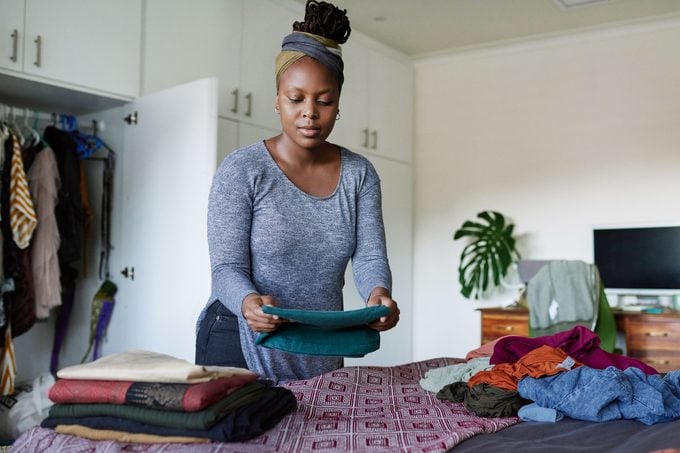
Hang vs fold
The benefits of hanging versus folding depend on the space you have available—drawer or closet space. If you have ample amounts of both, fold your pajamas, workout items, t-shirts, swimsuits, and other less frequently used items. The one item that should always be folded is sweaters. If you don’t have shelf space, Brookshire recommends folding them over a hanger so they maintain their shape.
How to fold clothes like Marie Kondo
Marie Kondo’s method of folding is all the rage. “This folding style is all about making differently shaped clothing items look uniform by tucking the edges, the neck, and hemlines and hiding any visible seams or straps,” Brookshire explains of Marie Kondo‘s technique. When all your similar clothing items are folded the exact same way, your drawers will naturally look neater and it will help you find what you’re looking for quickly.
Best way to hang clothes
When it comes time to hang clothes, resist just sloppily throwing them on just any old hanger; having all your clothes on like hangers instantly creates uniformity. After you’ve selected the best hanger, follow these simple steps:
- Face all of the items in the same direction to create a streamlined look.
- Order from short to long (so start with short sleeves then move on to elbow-length sleeves, etc.)
- Fold longer garments over the hanger to prevent dragging and catching.
- Color code so items are easy to locate and put back.
- If you have two rows of hanging items, put the bulkier items on the lower rack to keep the line of vision uncluttered. This will help the space feel more open and less overcrowded.
- Place empty hangers at the beginning of the section they came from to make returning clothes to their spot easy.
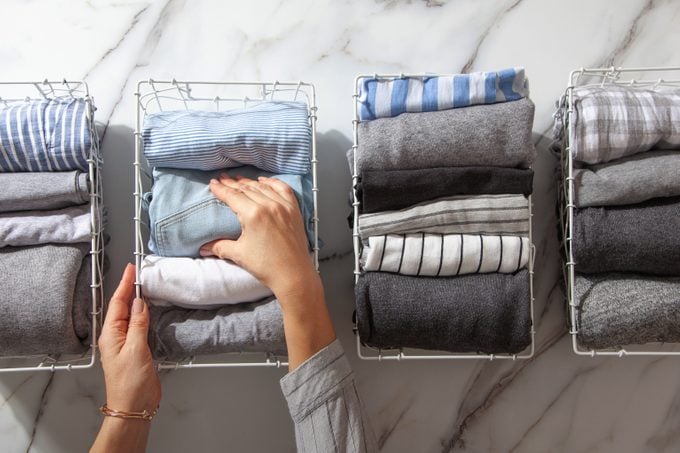
Space-saving techniques for clothes
To make more space in your closet, try some of these space-saving strategies:
- Rolling: You may already roll your clothes when you’re packing your suitcase for a trip. This saves space in your drawers, too, and works especially well for T-shirts, tanks, and smaller items of clothing.
- Hanging storage: Again, if you don’t have a lot of shelf space, consider hanging storage options for anything from your clothes to accessories or shoes.
- Vacuum bags: If you are storing clothes you don’t often wear, or want to tuck them away for the season, consider vacuum bags. Once the air is sucked out of these bags, you can store items in a fraction of the space.
- Seasonal storage: Speaking of, rotate out your out-of-season clothes from your main closet. You could store them in a guest bedroom or a well-ventilated basement. If you don’t have that much space, move them to the back of your closet.
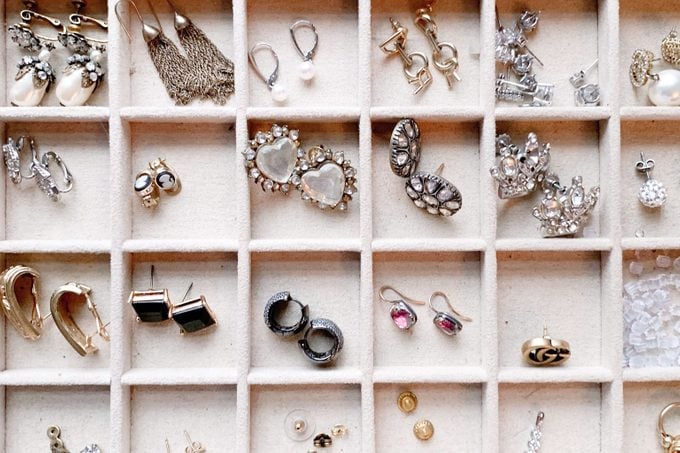
How to store your accessories
Once you have tackled your clothes, it is time to move on to all of your accessories, which should be stored separately from your clothes as they serve different functions. “Accessories are usually smaller and can be contained in a different way than clothing,” Brookshire says.
- Purses: One of the best purse storage ideas is to display them, similar to what you would see at a retail store. “This way, you can protect the shape of your purse and enjoy the eye candy of your collection,” she explains. For smaller clutches, invest in acrylic dividers that have slots for each clutch to slide into. If you have the option of heights and levels, acrylic shelf risers will allow you some additional aesthetic appeal. Tuck in the straps of smaller purses for a clean look, then sort them by size, color, or designer. Stuff your purses to keep the full shape visible and to better preserve them. Alternatively, if you more have hanging space than shelving, purses can also be hung on hooks.
- Jewelry: Organizing your jewelry can be a standalone project. Hang statement pieces for display, then store more delicate pieces in jewelry stacking trays to keep in a drawer. If you have a lot of jewelry and extra space, you can also consider a jewelry armoire, a stand-alone jewelry box, or another type of jewelry organizer.
- Shoes: When it comes to shoe storage ideas, try placing them on shelves or in drop-front shoe boxes. “If you don’t have built-in shelves, either of these solutions can create the illusion of a built-in shoe wall,” Brookshire says. Flat sandals and flip-flops can be tossed in a bin or basket that can be concealed but still organized, zoned, and easy to access.
- Socks: Fold or roll your socks, then store them out of sight in drawers or baskets.
- Belts: Resist the urge to hang your belts. “Belts can look messy when hung because they tend to warp from the shape of the user’s waist,” Brookshire explains. For a clean, visual look, roll them to place in a drawer or an accessory basket.
- Hats: Like handbags, Brookshire suggests giving your hats an opportunity to shine. “They are a beautiful accessory that should be displayed, not hidden away in a hatbox,” she says. You can either place them on a shelf or have them “climb the walls,” by hanging them on available wall space, which not only looks fetching but also has the benefit of making them easy to grab and go at a moment’s notice.
- Ties: Roll your ties to place them in a drawer, “like a sushi roll with the smallest end rolled first so the widest part is visible from the top,” Brookshire explains. Not only does it make for beautiful color blocking but allows an easy-to-find solution for any occasion.
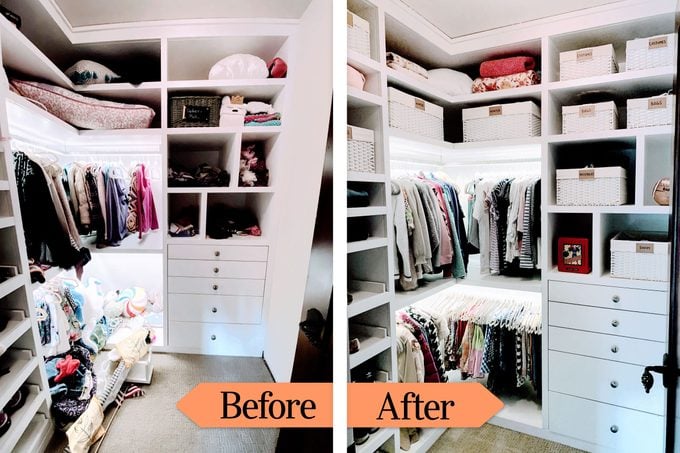
How to stay organized
Now that your closet is organized, you might think your work is done; however, that’s only half the battle—you need to commit to a plan to keep it that way. The good news is, once your closet is organized the right way, maintenance will be a whole lot easier.
- Make time for maintenance. “Regular tidying up will be the biggest key to success here,” states Brookshire. She suggests giving your space a spruce up once or twice a week with five minutes of attention. “Do this and you’ll never have to do a major overhaul again,” she promises.
- Don’t let laundry pile up. When it comes to laundry, don’t wait until your pile is brimming over. Do small loads instead, which will make it easier and more manageable for you to fold and hang all of your items versus having to spend hours doing it on a Sunday afternoon or worse—letting your clothing languish in the dryer. Here are a few tips for storing clothes during off-season.
- Continue to edit. A designated donate/sell bin right in your closet will help you stay on track when you find an item of clothing no longer works for you.
Best of all, now that your closet is fully organized and edited, you can tell at a glance what you have and what you need. This will enable you to thoughtfully and consciously add to your collection, instead of wasting money on things that are going to collect dust. When you do buy something new, consider a one-for-one policy where you donate an item for every new item you bring in.
Sources:
- Laynē Brookshire, CEO and founder of Ms. Placed Professional Organizing in Austin, Texas
- Jimmy Seifert, Closet Buyer at The Container Store


